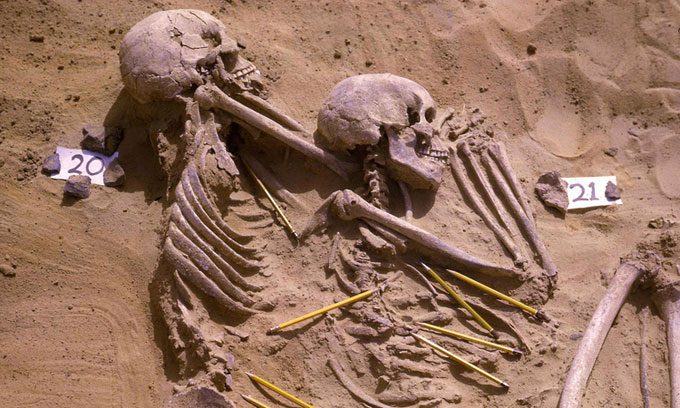Climate change caused ancient groups in the Nile Valley to compete for resources and territory through a series of conflicts.
Scientists have re-examined the remains excavated from the ancient cemetery of Jebel Sahaba, located in the Nile Valley of northern Sudan, since the 1960s and discovered that the individuals did not all die in a single battle, Daily Sabah reported on May 31. The new study was published in the journal Scientific Reports.

Two skeletons at the Jebel Sahaba cemetery, Sudan. (Photo: Reuters).
Among the 61 skeletons, which included men, women, and children, 41 exhibited signs of at least one injury, primarily from projectile weapons such as spears or arrows. Some injuries had healed, indicating that these individuals survived one battle. Sixteen individuals had both old and new injuries, meaning they survived one conflict but perished in another. Research from the 1960s identified only 20 skeletons with injuries, none of which had healed.
Violent altercations affected both men and women equally, with even children as young as four sustaining injuries, according to anthropologist Isabelle Crevecoeur from the French National Centre for Scientific Research, the lead author of the study. “It seems that one of the main lethal methods was cutting and causing blood loss,” Crevecoeur stated.
Spears and arrows were long-range weapons. However, the research team also found evidence of close combat. Some skeletons bore arm injuries from raising their arms to protect their heads and fractures in their hands.
The skeletons at the Jebel Sahaba cemetery date back 13,400 years. At this time, agriculture had not yet emerged. Inhabitants of the Nile Valley fished, hunted mammals, and foraged for roots and other plant parts. They lived in small groups, likely no more than 100 individuals.
Determining the causes of these conflicts is challenging. However, this period coincided with a time when the Nile Valley was undergoing climate change, shifting from arid to more humid conditions, along with severe flooding events. This could have led to competition for resources and territory among different groups.
“Unlike a specific battle or a short war, the violence here seems to have occurred frequently and was a part of daily life,” said Daniel Antoine, co-author of the study and head of bioarchaeology at the British Museum in London.
The Jebel Sahaba cemetery is now submerged beneath Lake Nasser, a large man-made reservoir. It is the oldest cemetery in the Nile Valley and one of the oldest in Africa. The remains are currently preserved at the British Museum.




















































